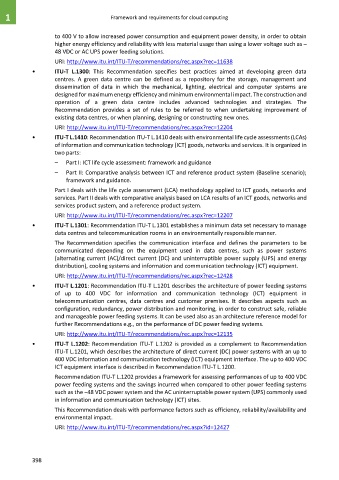Page 406 - Cloud computing: From paradigm to operation
P. 406
1 Framework and requirements for cloud computing
to 400 V to allow increased power consumption and equipment power density, in order to obtain
higher energy efficiency and reliability with less material usage than using a lower voltage such as –
48 VDC or AC UPS power feeding solutions.
URI: http://www.itu.int/ITU-T/recommendations/rec.aspx?rec=11638
• ITU-T L.1300: This Recommendation specifies best practices aimed at developing green data
centres. A green data centre can be defined as a repository for the storage, management and
dissemination of data in which the mechanical, lighting, electrical and computer systems are
designed for maximum energy efficiency and minimum environmental impact. The construction and
operation of a green data centre includes advanced technologies and strategies. The
Recommendation provides a set of rules to be referred to when undertaking improvement of
existing data centres, or when planning, designing or constructing new ones.
URI: http://www.itu.int/ITU-T/recommendations/rec.aspx?rec=12204
• ITU-T L.1410: Recommendation ITU-T L.1410 deals with environmental life cycle assessments (LCAs)
of information and communication technology (ICT) goods, networks and services. It is organized in
two parts:
– Part I: ICT life cycle assessment: framework and guidance
– Part II: Comparative analysis between ICT and reference product system (Baseline scenario);
framework and guidance.
Part I deals with the life cycle assessment (LCA) methodology applied to ICT goods, networks and
services. Part II deals with comparative analysis based on LCA results of an ICT goods, networks and
services product system, and a reference product system.
URI: http://www.itu.int/ITU-T/recommendations/rec.aspx?rec=12207
• ITU-T L.1301: Recommendation ITU-T L.1301 establishes a minimum data set necessary to manage
data centres and telecommunication rooms in an environmentally responsible manner.
The Recommendation specifies the communication interface and defines the parameters to be
communicated depending on the equipment used in data centres, such as power systems
(alternating current (AC)/direct current (DC) and uninterruptible power supply (UPS) and energy
distribution), cooling systems and information and communication technology (ICT) equipment.
URI: http://www.itu.int/ITU-T/recommendations/rec.aspx?rec=12428
• ITU-T L.1201: Recommendation ITU-T L.1201 describes the architecture of power feeding systems
of up to 400 VDC for information and communication technology (ICT) equipment in
telecommunication centres, data centres and customer premises. It describes aspects such as
configuration, redundancy, power distribution and monitoring, in order to construct safe, reliable
and manageable power feeding systems. It can be used also as an architecture reference model for
further Recommendations e.g., on the performance of DC power feeding systems.
URI: http://www.itu.int/ITU-T/recommendations/rec.aspx?rec=12135
• ITU-T L.1202: Recommendation ITU-T L.1202 is provided as a complement to Recommendation
ITU-T L.1201, which describes the architecture of direct current (DC) power systems with an up to
400 VDC information and communication technology (ICT) equipment interface. The up to 400 VDC
ICT equipment interface is described in Recommendation ITU-T L.1200.
Recommendation ITU-T L.1202 provides a framework for assessing performances of up to 400 VDC
power feeding systems and the savings incurred when compared to other power feeding systems
such as the −48 VDC power system and the AC uninterruptable power system (UPS) commonly used
in information and communication technology (ICT) sites.
This Recommendation deals with performance factors such as efficiency, reliability/availability and
environmental impact.
URI: http://www.itu.int/ITU-T/recommendations/rec.aspx?id=12427
398

